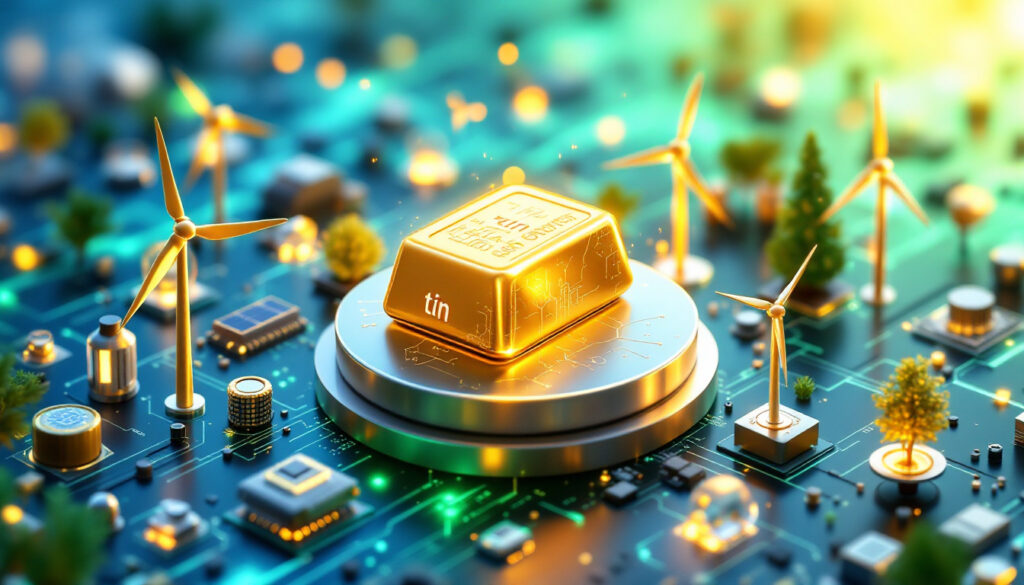Tin: The Unsung Hero of the Energy Transition
The global shift toward renewable energy and electrification has elevated the importance of certain minerals that might otherwise escape public attention. Among these critical materials, tin stands out as perhaps the most overlooked enabler of clean energy technologies. Often called the "glue" of the electronics industry, tin plays a foundational role in creating reliable electrical connections through solder, positioning it as an essential mineral for our clean energy future. The growing tin demand and energy transition are inextricably linked as we move toward a more sustainable world.
The Multifaceted Applications of Tin in Modern Technology
Tin's versatility extends across numerous applications that support the energy transition:
- Electronic circuit boards and components – where tin-based solder creates billions of electrical connections
- Renewable energy systems – particularly in solar panel manufacturing and grid infrastructure
- Electric vehicle manufacturing – for complex electronic systems and potential battery applications
- Energy storage solutions – in battery management systems and control electronics
- Advanced computing infrastructure – essential for AI development and cloud computing
- Telecommunications networks – enabling the connectivity that underpins smart energy systems
The International Tin Association (ITA) reports that 98% of tin in electronics is used as solder, highlighting its irreplaceable role in the tech economy.
Historical Context of Tin Usage
While tin has been utilized for millennia—most famously in bronze alloys and tin plating for food containers—its modern applications have evolved dramatically. Traditional uses in tinplate for packaging and chemicals are increasingly overshadowed by high-tech applications. This evolution represents a significant shift in how this versatile metal contributes to global industrial development.
As one ITA Technical Director noted in 2024: "Tin is irreplaceable in solder due to its unique combination of conductivity, ductility, and low melting point." This statement underscores why industries central to the critical minerals energy transition cannot function without this critical mineral.
How Will Energy Transition Technologies Drive Tin Demand?
The acceleration of clean energy technologies is creating unprecedented demand for tin across multiple sectors. According to the International Tin Association, global refined tin consumption is projected to increase from approximately 400 kilotonnes annually in 2025 to 450-500+ kilotonnes by 2030, representing substantial growth in a historically stable market.
Electronics Sector: The Primary Growth Engine
The electronics industry remains the largest consumer of tin, with several emerging technologies amplifying demand:
- Advanced Computing Infrastructure: Data centers supporting artificial intelligence require extensive electronic components, with each 10 MW facility requiring approximately 2.5 tonnes of tin (Lombard Odier Analysis, 2025)
- Internet of Things (IoT): The proliferation of connected devices is driving circuit board production at unprecedented scales
- 5G Network Expansion: Modern telecommunications infrastructure upgrades require significant tin-based solder, with 5G base stations requiring 40% more circuit boards than 4G predecessors (Kings Research, 2024)
- Consumer Electronics: Apple's iPhone 15, for example, uses approximately 3.2g of tin per device (ITA Case Study, 2023)
Electric Vehicles: A New Frontier for Tin Consumption
EVs typically contain significantly more tin than conventional vehicles, primarily due to their sophisticated electronic systems. According to Mordor Intelligence (2025), electric vehicles use 1.5-2 kg of tin compared to just 0.7 kg in conventional vehicles.
A Crux Investor Report (2024) projects that "EVs will drive 30% of incremental tin demand by 2030." This demand stems from:
- Complex Electronic Systems: Advanced driver assistance systems, infotainment, and battery management
- Circuit Board Density: Higher concentration of electronic components requiring solder connections
- Battery Applications: Tesla's Model Y contains 2.1 kg of tin in its battery management systems alone (Tesla Sustainability Report, 2024)
Renewable Energy Systems: Building the Clean Power Grid
Solar power generation has emerged as a major growth area for tin consumption:
- Photovoltaic Panel Manufacturing: Extensive use of tin solder in connecting solar cells, with demand growing at 20-25% annually (ITA, "Solar Power Emerging as Major Tin Use," 2024)
- Grid Infrastructure: Power management systems for renewable integration
- Offshore Wind: Each megawatt of offshore wind capacity requires approximately 1.2 kg of tin in converter stations (ITA, 2024)
- Energy Storage Solutions: Electronic components for battery management systems
The implementation of renewable energy solutions across industries is further driving this demand growth.
What Supply Challenges Could Impact the Tin Market?
Despite rising demand projections, the tin supply chain faces several significant constraints that could create market imbalances and potentially drive prices higher in the coming years.
Current Production Landscape
The global tin supply chain is heavily concentrated in Asia, with the ITA (2025) reporting that 70% of global supply comes from just four countries:
- Indonesia
- Myanmar
- China
- Peru
This geographical concentration creates inherent vulnerabilities in the supply chain, particularly as geopolitical tensions rise and resource nationalism grows more common.
Mining Industry Challenges
Several factors are creating potential supply bottlenecks:
- Underinvestment in Exploration: Limited capital allocation to new tin projects compared to more visible metals like copper and lithium
- Declining Ore Grades: Indonesian tin ore grades have declined from 2.5% to 1.8% since 2010 (IMARC Group, 2024)
- Development Timelines: As Mining Review Africa (2024) noted, "New tin mines take 10-15 years to reach production," creating a significant lag between market signals and supply response
- Capital Requirements: High costs associated with developing new tin resources in increasingly complex geological settings
These challenges underscore the need for mining industry innovation to overcome supply constraints.
Geopolitical Considerations
Supply security concerns include:
- Policy Changes: Myanmar's 2023 export restrictions reduced global supply by 8% (Resource World Magazine, 2024)
- Resource Nationalism: Growing government intervention in mining sectors across traditional producing regions
- Trade Disruptions: Supply chain vulnerabilities exposed by recent global events
- Concentration Risk: Heavy reliance on a small number of producing regions creates systemic vulnerabilities
How Significant is the Projected Supply-Demand Gap?
Market analysts predict a growing supply deficit emerging toward the end of this decade, potentially reaching 50-80 kilotonnes per year by 2030 (Mordor Intelligence, 2025). This gap creates potential opportunities for new production sources and recycling initiatives.
Market Dynamics Through 2030
- Demand Growth Rate: Potentially exceeding historical trends due to clean energy acceleration
- Supply Response: Lagging behind consumption increases due to long lead times for new mines
- Price Implications: Potential for sustained higher prices to incentivize investment
- Strategic Importance: Growing recognition of tin as a critical mineral for energy security
Addressing the Deficit
Several approaches will be necessary to meet future demand:
- Accelerated Exploration: Identifying and developing new tin resources like Brazil's Taboca Mine expansion (+15 kilotonnes/year by 2027, MINING.COM, 2024)
- Mining Technology Improvements: Enhancing recovery rates from existing operations
- Recycling Initiatives: Currently, recycling provides 30-35% of global tin supply (ITA, "Tin Recycling Report," 2023)
- Substitution Research: Exploring alternatives for certain applications, though MIT's 2024 study on conductive polymers found no viable alternatives for critical electronics applications
As the ITA Supply Chain Report (2024) stated: "Recycling could fill 40% of the gap, but mining expansion is non-negotiable." This highlights the necessity of developing new primary production capacity to avoid severe market tightness. Furthermore, advancements in battery recycling process technologies could contribute significantly to mitigating supply challenges.
What Makes Tin Essential for Electronics Manufacturing?
Tin's role in electronics manufacturing is irreplaceable due to its unique physical and chemical properties that enable reliable electrical connections. This technical profile explains why tin remains central to technologies driving the energy transition.
The Science Behind Tin Solder
- Low Melting Point (232°C): Allows for precise application without damaging sensitive components
- Excellent Conductivity: Provides reliable electrical connections essential for power management
- Resistance to Oxidation: Maintains performance over time even in challenging environments
- Mechanical Strength: Creates durable bonds between components that can withstand thermal cycling
These properties make tin essential for high-reliability applications in renewable energy systems and electric vehicles where failure is not an option.
Evolution of Solder Technology
The transition to lead-free solder has increased tin content in electronic assemblies:
- Environmental Regulations: EU RoHS Directive and similar global standards have driven higher tin percentages in solder formulations (≥95% tin)
- Performance Requirements: Demanding more sophisticated tin alloys to replace lead's beneficial properties
- Miniaturization Trends: Requiring more precise soldering techniques for increasingly dense components
According to the ITA Technical Report (2024), "Lead-free solder increased tin usage by 50% in consumer electronics." This regulatory-driven change has significantly amplified tin's importance in modern manufacturing.
For specialized applications like aerospace electronics, standards such as ISO 20918:2023 govern tin whisker mitigation techniques, demonstrating the technical sophistication required in modern solder applications.
How Do Different Clean Energy Technologies Impact Tin Demand?
Various energy transition technologies have different tin intensity requirements, creating a complex demand landscape that affects both production forecasts and investment needs. The tin demand and energy transition relationship varies significantly across different technological applications.
Comparative Tin Requirements
| Technology | Tin Usage Intensity | Primary Applications | Market Growth Projection |
|---|---|---|---|
| Solar PV | High | Cell connections, inverters | 20-25% annual growth |
| Wind Power | Moderate | Control systems, generators | 15-20% annual growth |
| Electric Vehicles | High | Electronics, potential batteries | 25-30% annual growth |
| Energy Storage | Moderate-High | Battery systems, controls | 30-35% annual growth |
| Smart Grid | Moderate | Sensors, control systems | 15-20% annual growth |
Technology-Specific Considerations
Different clean energy applications present unique opportunities and challenges for tin usage:
- Solar Energy: Requires high-reliability solder connections that can withstand temperature fluctuations and decades of outdoor exposure
- Electric Mobility: Demands miniaturized electronics with high durability standards to withstand vehicle vibration and temperature extremes
- Grid Infrastructure: Needs weather-resistant connections for outdoor applications in transmission and distribution equipment
- Energy Storage: Requires advanced electronic management systems to optimize battery performance and safety
An emerging application not widely recognized is tin's role in hydrogen electrolyzers, with the ITA's 2024 hydrogen report documenting increasing use in this growing sector of the energy transition.
What Investment Opportunities Exist in the Tin Sector?
The projected supply-demand imbalance creates potential investment opportunities across the tin value chain, from production to recycling and technology applications.
Mining Project Development
- Exploration Companies: Early-stage resource identification in historically underexplored regions
- Development Projects: Advanced-stage mines approaching production, such as Eloro Resources' Iska Iska Project with a 5.6 Mt inferred resource @ 0.15% tin (Eloro Press Release, 2024)
- Existing Producers: Expansion of current operations and technological improvements
Rio Tinto's implementation of AI-driven ore-sorting technology at their tin operations represents the kind of innovation that could improve productivity at existing mines.
Recycling and Circular Economy
- E-Waste Processing: Recovery of tin from electronic products, currently providing 30-35% of global supply
- Refining Technology: Advanced separation techniques to improve recovery rates
- Collection Systems: Improving recovery rates of tin-containing products, potentially influenced by the EU's 2024 WEEE Directive targets
Securing critical raw materials supply chains will likely become an increasingly important focus for governments and industries alike.
Technology Applications
- Advanced Solder Formulations: Specialized alloys for emerging applications in extreme environments
- Battery Research: Potential tin-based energy storage solutions under development
- Manufacturing Efficiency: Reducing tin waste in production processes through precision application technologies
FAQ: Tin and the Energy Transition
How does tin compare to other critical minerals in terms of supply risk?
Tin faces moderate to high supply risk compared to other critical minerals. Unlike copper or aluminum, tin production is concentrated in fewer countries, with significant output from regions with potential geopolitical or regulatory uncertainties. Additionally, tin has fewer readily available substitutes for its primary applications, particularly in electronics manufacturing. MIT's 2024 study on conductive polymers confirmed that no viable alternatives exist for critical electronics applications.
Can recycling significantly address future tin supply challenges?
Recycling presents a significant opportunity to supplement primary tin production. Currently, approximately 30-35% of global tin supply comes from secondary sources, primarily from electronic waste (ITA, "Tin Recycling Report," 2023). With improved collection systems and processing technologies, this percentage could potentially increase to 40-45% by 2030. However, recycling alone cannot fully address projected demand growth, making new mine development essential.
What technological innovations might affect tin demand projections?
Several technological developments could impact future tin consumption patterns:
- Advancements in miniaturization that reduce the amount of solder required per device
- Development of alternative conductive adhesives for specific applications
- Improvements in manufacturing precision that minimize waste
- Breakthrough battery technologies that either increase or decrease tin requirements
NASA's tin solder specifications for Mars rovers demonstrate how specialized applications continue to rely on tin's unique properties despite ongoing research into alternatives.
How might climate policies influence the tin market?
Climate policies generally support increased tin demand through:
- Accelerated renewable energy deployment targets
- Electric vehicle adoption incentives
- Grid modernization initiatives
- Electronic waste recycling regulations
- Carbon pricing mechanisms that favor electrification
The EU's updated 2024 WEEE Directive targets will likely further support tin recycling rates while also indirectly supporting demand for new production.
Conclusion: Tin's Critical Role in the Clean Energy Future
Tin stands at the intersection of multiple technological megatrends driving the global energy transition. Its essential role in electronics manufacturing positions it as a critical enabler of renewable energy systems, electric vehicles, and the digital infrastructure necessary for a low-carbon economy.
The projected growth in tin demand, potentially reaching 450-500+ kilotonnes annually by 2030, highlights the metal's strategic importance. However, supply constraints resulting from underinvestment in new production capacity, declining ore grades, and geopolitical considerations create a challenging market outlook.
Addressing the anticipated supply-demand gap will require coordinated efforts across the value chain, including accelerated exploration, improved mining technologies, enhanced recycling initiatives, and research into more efficient applications. For investors, policymakers, and industry participants, understanding tin's pivotal role in the energy transition provides valuable insight into one of the less-discussed but critically important elements of building a sustainable future.
Further Exploration:
Readers interested in learning more about tin's role in the energy transition can also explore related educational content from industry organizations such as the International Tin Association, which provides research on tin markets, technologies, and applications.
Want to Get Ahead of the Next Major Mineral Discovery?
Discovery Alert's proprietary Discovery IQ model instantly notifies investors about significant mineral discoveries across the ASX, transforming complex data into actionable opportunities before the broader market reacts. Explore why early identification of major discoveries like tin can generate substantial returns by visiting Discovery Alert's dedicated discoveries page.




